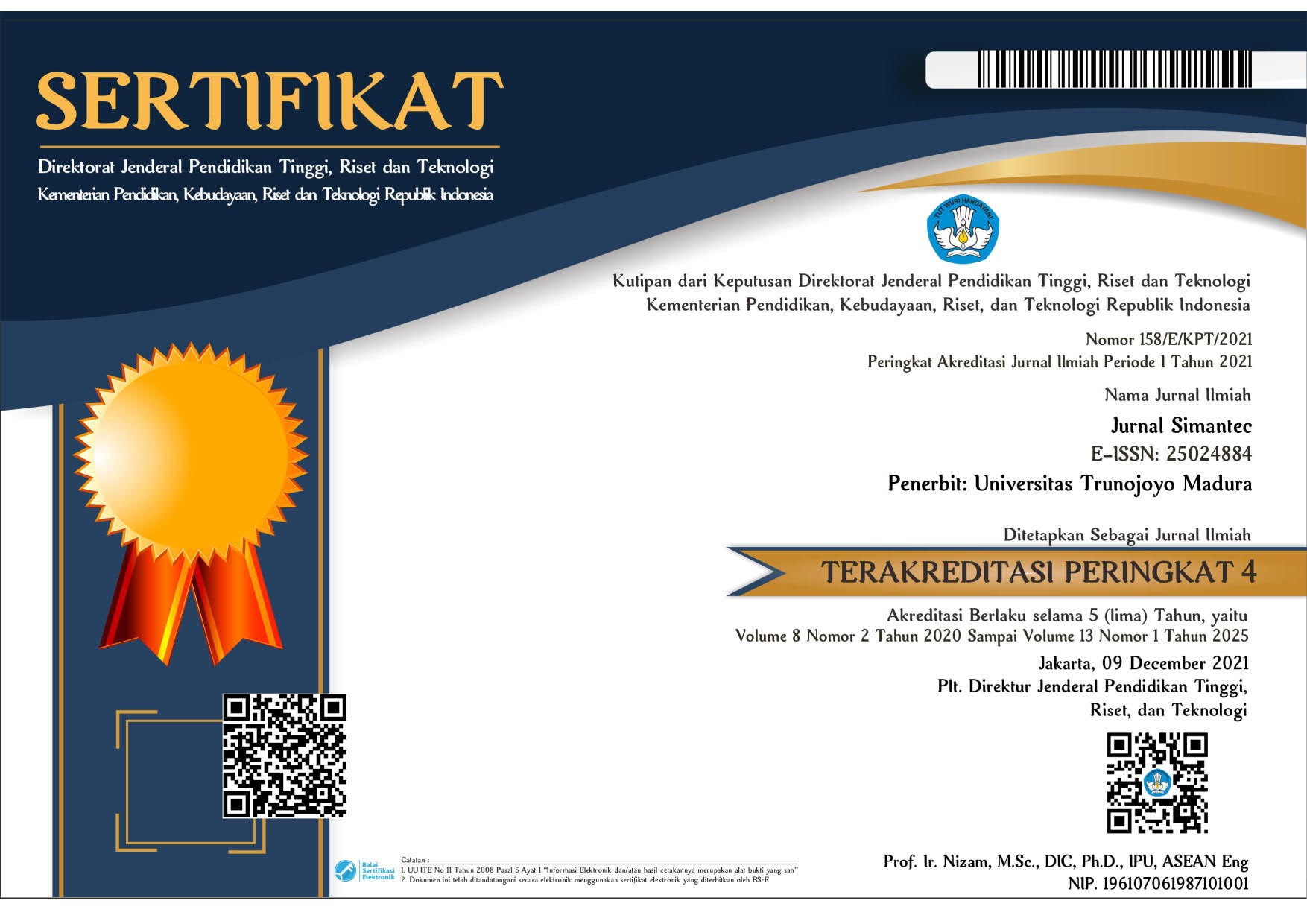DETEKSI KEJANG EPILEPSY DENGAN MENGGUNAKAN PEMILIHAN FITUR INFORMATIOAN GAIN DAN PEMBELAJARAN ENSEMBLE RANDOM FOREST
Abstract
Full Text:
PDF (Bahasa Indonesia)References
P. Kandula and C. Harden, "Epilepsy," in Encyclopedia of Neuroscience, L. R. Squire, Ed., ed Oxford: Academic Press, 2009, pp. 1147-1149.
H. E. Scharfman, "Chapter 17 - Epilepsy," in Neurobiology of Brain Disorders, M. J. Zigmond, L. P. Rowland, and J. T. Coyle, Eds., ed San Diego: Academic Press, 2015, pp. 236-261.
A. Michael-Titus, P. Revest, and P. Shortland, "13 - EPILEPSY," in The Nervous System (Second Edition), A. Michael-Titus, P. Revest, and P. Shortland, Eds., ed: Churchill Livingstone, 2010, pp. 237-250.
R. İnce, S. S. Adanır, and F. Sevmez, "The inventor of electroencephalography (EEG): Hans Berger (1873–1941)," Child's Nervous System, 2020/03/05 2020.
J. G. Small, "3 - EEG IN AFFECTIVE DISORDERS," in EEG and Evoked Potentials in Psychiatry and Behavioral Neurology, J. R. Hughes and W. P. Wilson, Eds., ed: Butterworth-Heinemann, 1983, pp. 41-54.
M. Lavanga, J. De Ridder, K. Kotulska, R. Moavero, P. Curatolo, B. Weschke, et al., "Results of quantitative EEG analysis are associated with autism spectrum disorder and development abnormalities in infants with tuberous sclerosis complex," Biomedical Signal Processing and Control, vol. 68, p. 102658, 2021/07/01/ 2021.
E. Minato and K. A. Myers, "Age-related evolution of EEG in Dravet syndrome: Meta-analysis of 155 patients," Seizure, vol. 91, pp. 108-111, 2021/10/01/ 2021.
H. Ocak, "Optimal classification of epileptic seizures in EEG using wavelet analysis and genetic algorithm," Signal Processing, vol. 88, pp. 1858-1867, 2008/07/01/ 2008.
E. D. Übeyli, "Combined neural network model employing wavelet coefficients for EEG signals classification," Digital Signal Processing, vol. 19, pp. 297-308, 2009/03/01/ 2009.
E. D. Übeyli, "Combining recurrent neural networks with eigenvector methods for classification of ECG beats," Digital Signal Processing, vol. 19, pp. 320-329, 2009/03/01/ 2009.
R. Dhiman, J. S. Saini, and Priyanka, "Genetic algorithms tuned expert model for detection of epileptic seizures from EEG signatures," Applied Soft Computing, vol. 19, pp. 8-17, 2014/06/01/ 2014.
S. Yang, B. Li, Y. Zhang, M. Duan, S. Liu, Y. Zhang, et al., "Selection of features for patient-independent detection of seizure events using scalp EEG signals," Computers in Biology and Medicine, vol. 119, p. 103671, 2020/04/01/ 2020.
B. Direito, J. Duarte, C. Teixeira, B. Schelter, M. L. Van Quyen, A. Schulze-Bonhage, et al., "Feature selection in high dimensional EEG features spaces for epileptic seizure prediction," IFAC Proceedings Volumes, vol. 44, pp. 6206-6211, 2011/01/01/ 2011.
V. Harpale and V. Bairagi, "An adaptive method for feature selection and extraction for classification of epileptic EEG signal in significant states," Journal of King Saud University - Computer and Information Sciences, 2018/05/24/ 2018.
E. Pippa, E. I. Zacharaki, I. Mporas, V. Tsirka, M. P. Richardson, M. Koutroumanidis, et al., "Improving classification of epileptic and non-epileptic EEG events by feature selection," Neurocomputing, vol. 171, pp. 576-585, 2016/01/01/ 2016.
A. H. Shoeb, "Application of machine learning to epileptic seizure onset detection and treatment," Massachusetts Institute of Technology, 2009.
R. Q. Quiroga, S. Blanco, O. Rosso, H. Garcia, and A. Rabinowicz, "Searching for hidden information with Gabor Transform in generalized tonic-clonic seizures," Electroencephalography and clinical Neurophysiology, vol. 103, pp. 434-439, 1997.
T. Higuchi, "Approach to an irregular time series on the basis of the fractal theory," Physica D: Nonlinear Phenomena, vol. 31, pp. 277-283, 1988.
A. Petrosian, "Kolmogorov complexity of finite sequences and recognition of different preictal EEG patterns," in Proceedings eighth IEEE symposium on computer-based medical systems, 1995, pp. 212-217.
T. Balli and R. Palaniappan, "A combined linear & nonlinear approach for classification of epileptic EEG signals," in 2009 4th International IEEE/EMBS Conference on Neural Engineering, 2009, pp. 714-717.
T. Inouye, K. Shinosaki, H. Sakamoto, S. Toi, S. Ukai, A. Iyama, et al., "Quantification of EEG irregularity by use of the entropy of the power spectrum," Electroencephalography and clinical neurophysiology, vol. 79, pp. 204-210, 1991.
B. Hjorth, "EEG analysis based on time domain properties," Electroencephalography and clinical neurophysiology, vol. 29, pp. 306-310, 1970.
I. Koprinska, "Feature selection for brain-computer interfaces," in Pacific-Asia conference on knowledge discovery and data mining, 2009, pp. 106-117.
L. Rokach, Pattern classification using ensemble methods vol. 75: World Scientific, 2010.
DOI: https://doi.org/10.21107/simantec.v9i2.11084
Refbacks
- There are currently no refbacks.
Copyright (c) 2021 Mulaab Mulaab
Indexed By
.png)

11.png)













